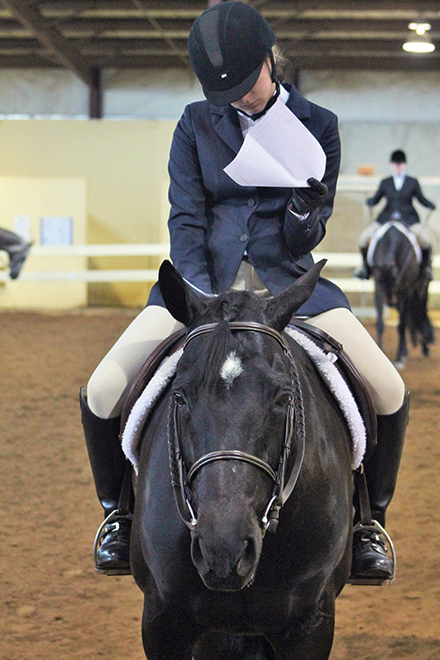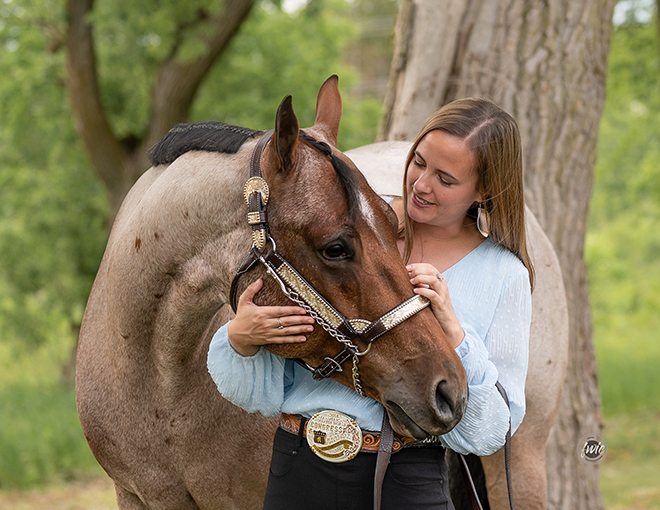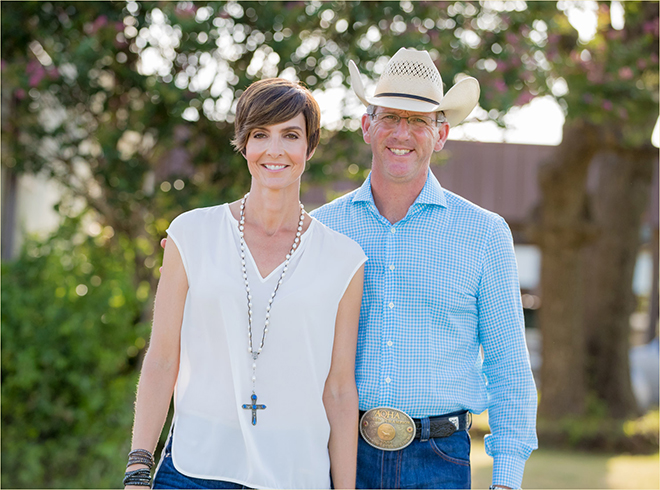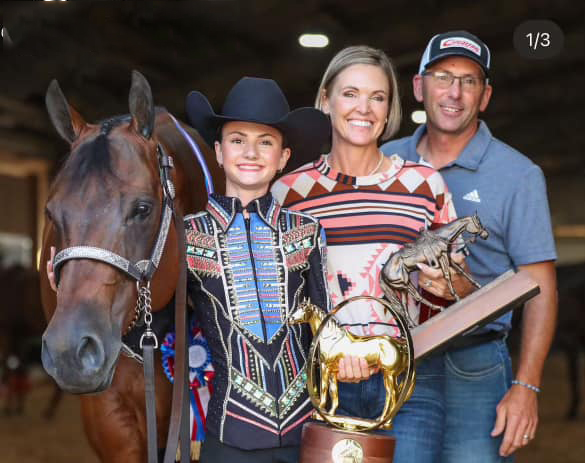Competition in the pattern classes at top breed shows and futurities has improved so much in the past decade that course designers have had to add maneuvers and to the degree of difficulty just to keep up and make the classes challenging.
Some of today’s Showmanship Horsemanship, Equitation, Trail and Ranch patterns can get extremely complicated.
Not only does this make them a challenge to ride, but it can be equally, if not more challenging, to memorize the pattern – especially when nerves come into play.
Here we take a look at the tricks successful riders and trainers use to remember these challenging patterns and offer advice on how to quickly recover when a mistake is made.
What Makes A Challenging Pattern?
Sometimes, we don’t exactly know what went wrong when we blew the pattern despite having thought we memorized it perfectly.
That’s why it’s important to understand where these common trip ups in pattern memorization are, and why they are happening.
Oftentimes, it’s not the big, hard maneuvers that can trip riders up when it comes to remembering their pattern. In fact, it’s the small things in the middle that can likely be the hardest part to recall.
“It’s the small things like turning one way here or turning and then backing up – combinations like that. It’s not the big things or the big picture, it’s these little details that, especially in the middle of a pattern, are harder to remember in the sequence,” said professional trainer Michael Colvin, of Maryland. “When they put these little maneuvers in the middle and in conjunction with something else, it’s those areas that are a little challenging to get locked into memory. It takes a little bit of extra work to get that locked into memory, even with my best riders. This is why it’s good to get some muscle memory going. I’m not a fan of practicing the pattern a hundred times.”
The Never Ending Pattern
Patterns at the bigger shows can be not only complex, but extremely long too – making them that much more challenging to memorize.
American Quarter Horse Association (AQHA) competitor Katie Kopf, of Edwardsburg, Michigan knows all too well the challenge that comes with memorizing a Trail or Showmanship pattern.
“I would say the most challenging pattern I have faced was the Level 3 Amateur Trail finals pattern at the 2023 AQHA World Show – it was at least five minutes long,” she said.
Kopf and her show partner, Two Ziplines, finished as Reserve Champions in the tough class of 45 competitors but she admits the course was a challenge.
“I take a lot of the notes on a hardcopy, and the notes I make consist of key words that I use to help remind me to stay in the moment while completing the pattern,” she advised.
For riders who are moving up the levels, keep in mind these patterns might also be posted with very little time for memorization
Texas trainer Robin Frid said the Invitational Horsemanship Challenge pattern at this year’s National Snaffle Bit Association (NSBA) World Championship Show was a perfect example.
“They (competitors) have to learn four patterns, and then they are given one 10 minutes before they compete,” he explained. “We really try to identify if there is something odd in the pattern. So, for example, where is the backup in this pattern? Is it in an odd place? Is it in a position where it’s leading you to forget about it? Because quite often that’ll happen – they’ll put a maneuver in where it seems you could forget it. We really try to discuss that point, whether it’s a spin to a backup or a backup to a spin. We won’t say backup then spin, because we’ll create it into one maneuver in our heads to help the memorization process.”
Tips for Memorizing Patterns
First, it’s helpful to consider the best way you learn and lean into this learning method when it comes to pattern memorization.
“People learn differently or memorize things differently. For example, some are visual learners, some are repetitive learners, some are auditory learners,” Colvin said.
These days, there’s many ways to have a copy of the pattern handy for memorization, such as a picture on your phone. But the best method might still be a piece of paper that can be marked up with notes and highlighted.
Indiana professional trainer and coach Melissa Jones uses the method with all of her clients, including her daughter, Lilly.
“One of the things I have my clients and daughter do to remember hard patterns is to highlight them – it’s simple, but very effective,” she explained. “At the Youth World Show, before Lilly would go to bed, I would have her look over her pattern for the next day and think about how she wanted it to go. It’s also a good idea to video the ride of that pattern and watch it.”
While it may seem like a good idea to run your horse through the pattern numerous times to help with memorization, it might actually be more beneficial to you and your horse to continue the memorization process on foot.
“I make sure to walk those long patterns at least five times the morning of the class, and I made a lot of notes after I did so on that hardcopy of the pattern,” adds Kopf.
When walking the pattern during the memorization process, one of the key factors will be to consider your path.
“When I’m learning a Trail pattern, I think about the path when I practice the pattern and walk the course. I think about how I would like it to go,” Jones said.
Frid suggests you think of your horse’s perspective.
“Think of things in reverse, instead of how you’re going to get to a certain spot,” he said. “Because when you’re riding, it’s different than when you’re walking on the ground as to what a horse can actually do. This is why I will do things in reverse. And once we learn the pattern, now we can figure out how to get to the center of the pen rather than trying to find our way there. This will help you find your line a whole lot easier.”
The path well-traveled
Remember, if you aren’t the first to go, there is already a path set out for you.
“You don’t have to recreate anything unless you’re the first one to go,” Colvin said. “There’s usually a very distinct hoofprint path that you can follow, so just ‘follow the yellow brick road’ is what I tell my students all the time.”
A lot of times, in conjunction with this muscle memory they’ve hopefully created, they’ll follow the path that’s been created by others and it’ll all work together,” Colvin explained.
One thing to think about when memorizing your pattern is if you’re going from a forward gait to slower maneuver.
“Normally the horses are pretty trained, and they follow you just fine, but it’s the rider that might have a hard time calming their energy down and calming their body down,” Frid said. “If your body is not giving them the proper cue, then they’re not going to be able to follow you very easily. With the pattern memorization, we also talk about where are the places that you might need to tighten your body and strengthen your body a little bit? Where are places that you need to soften your body? So that comes into the memorization of the pattern as well for going down to those slower maneuvers.”
Have a Backup Plan
Have a plan, but if that plan doesn’t seem to be going the way you hoped, it’s good to have a backup plan when you’re out in the arena.
“I think about backup plan when I’m walking my pattern in case I don’t get the path I wanted. One little tip I tell my clients is if you lose your path, follow the hoof prints!”
When it comes to recovering from a bad maneuver or a near miss in the pattern you thought you had memorized, remember that is only one small part of the overall score.
“It’s ok if you make a mistake in any of the patterns, and it doesn’t matter if it’s Western Riding, Trail, Ranch Riding, Horsemanship, Showmanship, etc. They are all scored for mathematical gain, so you can make an error in one place, it doesn’t mean you’re out or that it’s a bomb. Because if you’ve done well on the other ones, and then you do well on the on the following maneuvers, you still can be okay. So, try not to let yourself get defeated just because you make an error, or you don’t have a great maneuver, because it is a mathematical game in the end.”
And sometimes, despite your plan and backup plan, you might also need a plan C. With the help of her trainer, Melissa Jones, Kopf formulates a plan A, plan B and even plan C.
“Plan C is to close my eyes for a moment and let my horse figure it out for each maneuver of the pattern,” she said.
That’s good advice. When in doubt on course, allow yourself a ‘beat’ to collect yourself and remember your next move.
“If you get disoriented for a moment, give yourself a beat, don’t just continue blindly,” Colvin said. “Let’s say you turn, and then you have to think what the next thing is. Just allow yourself that extra beat because the beat is never as long to watch as it plays out in your head. It feels much longer than it really is.”







You must be logged in to post a comment Login